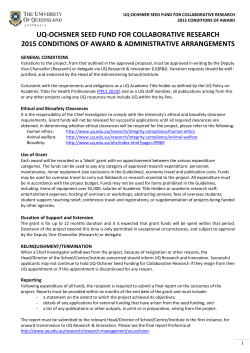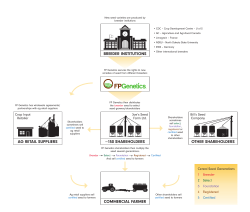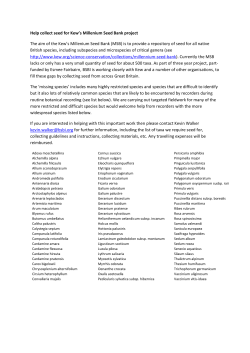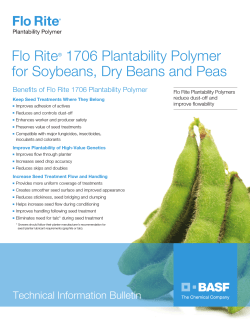
Sustainable Contract Farming for Increased - D8
Seed System of Bangladesh 1. Introduction : Bangladesh is an agrarian country and its economy depends more or less on agriculture. Her employment, export and almost all activities related to economic development depend on Agriculture. It contributes about 16.33% to the Gross Domestic Product (GDP). Agriculture employs about 50% of the labor force. Not only has it provided food but also raw materials to industry sector. Bangladesh agriculture has made enormous strides in the last 34 years, raising food grains production from 70 lakh mt. ton to 3 core 66 lakh mt. ton. In the process the country has progressed from a situation of food shortages and imports to one of surpluses and exports. Having achieved food sufficiency the aim is to achieve food and nutritional security at the house hold level. Quality seed is one of the most important agricultural inputs to ensure food security. Quality seed can also enhance the utilization efficiency of others associated agricultural inputs such as fertilizers, irrigation etc. Use of quality seed only can enhance the productivity by 15-20 percent. 2. Status of Seed : Seed is the most valuable and vital input for increasing agricultural product. But it has to go a long way to establish its importance. Several steps were taken for its development at different stages. Seeds in Bangladesh are procured from two different sources, locally produced seed and imported seed. The seed sector has made impressive progress over the last three decades. The quantum of quality seed supplied increased from 7000 mt. ton to 2 lakh mt. ton. 3. Present Organizational Structure : Present organizational structure is broad-based involving public & private sector participation under the guided policy as adopted in the National Seed Policy. The stakeholders under the structure are: i) ii) iii) iv) v) National Seed Board. Seed Wing of the Ministry of Agriculture. Bangladesh Agriculture Development Corporation. Seed Certification Agency. National Agricultural Research System. Bangladesh Agricultural Research Institute. Bangladesh Rice Research Institute. Bangladesh Jute Research Institute. Bangladesh Institute of Nuclear Agriculture. All Public Agricultural University. vi) vii) viii) ix) Department of Agriculture Extension. Cotton Development Board. Agriculture Information Service. Bangladesh Seed Association. 4. Creation of Seed Wing and Seed Legislation : Seed Wing has been created in 1992 in the Ministry of Agriculture to serve as a Secretariat of National Seed Board and to assist and implement seed related govt. policies. Seed Wing has been assisting and coordinating among different organization implementing for the National Seed Policy, 1993. The Ordinance, 1977 has been amended and Seed Rules have been formed in 1998 there under to keep pace with the National Seed Policy. Beside to protect Plant Varieties and Farmer’s Rights and to comply with the WTO Rules, Draft Plant Variety and Farmer’s Right Protection Act and Plant Quarantine Act (Amended) have been prepared. D:\Dell\Desktop\Seed System of Bangladesh-2015.doc 1 5. Role of different sectors of seed system 5.1 Pubic Sector i) Ministry of Agriculture. (MOA) : Ministry of Agriculture looks after all the activities related to seed management through its Seed Wing. Preparing, adopting & administrating policies, acts, rules & regulations related to seed activities are done by the Ministry. Different statutory organization and bodies such as National Seed Board, Seed Certificate Agency are the implementing organizations. ii) National Seed Board (NSB) : National Seed Board (NSB) established in 1974, is the statutory body comprising of concerned 19 officials and representative NSB advice Government on different seed management activities such as the application of seed, acts, rules, policy, variety release and registration, quality control fixation of seed standards etc. NSB consist of (1) Technical Committee and (2) Seed promotion committee. Technical committee through meeting prepares recommendation on certain matter for consideration of the NSB and solely responsible to recommended about the release of a variety. Seed promotion committee is responsible for promoting use of quality seed and generally decides about quantity of seed to be supplied and variety to be promoted. iii) Seed Certification Agency (SCA) : It was established in 1974 is a statutory, which is authorized to undertake seed certification of released varieties. Seed fields of the intending organization or farmers are inspected and seed samples are collected by the field officer of the SCA. On the basis of this field inspection and testing certification tags are provided. Field officers have also been authorized to verify marketed seed for quality. iv) Bangladesh Agricultural Development Corporation (BADC) : Bangladesh Agricultural Development Corporation is a public corporation responsible for multiplication, processing, preservation and marketing of seeds of different crops. BADC has 32 seed multiplication farm, 9 Horticultural Development Centre, 13 Agro-Service Centre, 52 Seed Processing Centre, 18 Cold Storage and 100 Seed Sales Center & 7,050 Seed Dealer all over the country. BADC produces 1,40,000 mt. seed in last 2013-14 year (Attached : Appendix-D). v) National Agricultural Research System (NARS) : Bangladesh Agricultural Research Institute (BARI), Bangladesh Rice Research Institute (BRRI), Bangladesh Jute Research Institute (BJRI), Bangladesh Sugarcane Research Institute(BSRI), Bangladesh Institute of Nuclear Agriculture (BINA), Research activities of Bangladesh Agriculture University (BAU) and Bangabandhu Sheikh Mujibur Rahman Agricultural University (BSMRAU) from the National Agriculture Research System (NARS). BARI, BRRI, BJRI have regional research centers in different parts of the country. The Research Activities of all organization are coordinated by Bangladesh Agricultural Research Council (BARC). All National Agricultural Research Institute is Responsible for Variety Release & Breeder Seed Production according to Seed Act. NARS supplies Breeder Seed to BADC & Private sector. vi) Department of Agriculture Extension (DAE) : It is the biggest organization under Ministry of Agriculture having its staff down to village level, Agricultural Technology Developed in the Research Institution of the NARS are taken to the farmers through this elaborate extension systems. Besides D:\Dell\Desktop\Seed System of Bangladesh-2015.doc 2 there are technical committee at national, regional and district level for determining requirement of some technology and to provide feed back to the NARS. DAE has started “farmers level seed production project in 1999”. They produces 65820 mt. of different crops seed in 2012-13 by this project. 5.2 Private Sector i) Bangladesh Seed Association (BSA) : This is a registered organization formed by the seed merchants who are engaged mostly in procuring seed from home and abroad and marketing. It is managed through an executive committee having a president and a General Secretary. It has about 200 registered members. It has a representative in the National Seed Board. ii) Traditional Marketing Network : Like the marketing of consumable articles, there exist a very strong marketing network having wholesaling and retaining outlet, handle by the private seed business man. iii) The private sector has already started variety development research. A couple of private seed companies and NGO’s are importing parent lines of hybrid rice, hybrid maize etc. producing seeds and successfully marketing the seed under their respective level. In case of vegetables seed, the situation is more encouraging. Besides the varieties developed in the public sector research institute BARI, the private has developed many varieties of red amaranthus, white amaranthus, Okra & long beans through selection process. The Private sector is still lacking behind in seed technology research, because accept 1 no other company could developed facilities required for carrying out seed technology research. iv) Name of Leading Private Seed Industry in Bangladesh : 1) 2) 3) 4) 5) 6) 7) 8) 9) 10) 11) 12) Advanced Chemical Industries (ACI) Supreme Seed Company Ltd. Lal Teer Seed Company Ltd. Aftab Seed Ltd. Isphahani Agro Ltd. Metal Seed Ltd. Bayer Crop Science Ltd. Syngenta Bangladesh Ltd. Getco-Agro Vision Ltd. Petrochem Bangladesh Ltd. Partex Agro Ltd. Rahim Afroz Ltd. v) Number of Seed Dealer Registered with Seed Wing, MoA : 20,000 Seed Dealer Registration Certificate already issued for seed business in all over Bangladesh. vi) Bangladesh Society of Seed Technology (BSST) : Bangladesh Society of Seed Technology was established in the year 1996 with the following aims and objectives : Aims and Objectives : Bangladesh Society of Seed Technology is a professionals, non-political and not for profit making organization and work for promotion of Seed Technology. Promote scientific, technological and professional jobs in the field of seed research, seed production, seed processing, seed storage, seed testing, seed certification, seed marketing, seed law enforcement and any other aspects related to seed technology. D:\Dell\Desktop\Seed System of Bangladesh-2015.doc 3 5.3 Works towards maintaining fullest cooperation, highest proficiency and professional standard among all seed technologists including personnel engaged in seed research, seed production, seed processing, seed storage, seed testing, seed certification, seed marketing, seed law enforcement and any other aspects related to seed technology. Encourage developing mutual understanding and professional interests among technologists involved in the field of seed technology. Encourage research on different aspects of seed technology. Accumulate educational training programme, national and international seminars, workshop, conferences, symposium etc for promotion of seed technology. Cooperate with government, universities, research institutes, seed associations, private seed companies, NGOs and all other others agencies interested in promotion of seed technology and the use of Quality Seed. Publication of technical books and journals, periodicals, booklets, pamphlets, print and electronic media materials on seed technology. Take up any other activities which necessary for promotion of seed technology. Non Government Organization (NGO) : There are many non-government organizations working in the country. Some NGO’ like BRAC, Proshika, Gono Kalyan Trust, TMSS have been attending agricultural activities in an organized way. They have also started activities like seed research, multiplication, processing and marketing. BRAC is on of the pioneer NGO engaged in seed production. They produce hybrid rice seed locally by reducing import. RDRS is also engaged in seed production mainly in rice seed production for drought prone area. 6. Variety Registration : For registration of a variety of notified (namely rice, wheat, jute, potato, sugarcane, mesta & kenaf) crops, 2-3 years trail is conducted by SCA/ Research organization for approval by the Technical Committed. and for registration of varieties for non-notified crops the breeder or innovator has to apply to secretary, National Seed Board (DG, Seed Wing, Ministry of Agriculture) and NSB provides registration on the basis of the information given on the application. 7. Demand and Supply of Quality Seed : In the recent years supply of quality seed both from public and private sector has shown a very remarkable increase. The following table show the quantity of different seed supplied in the year 2009-10 to 2013-14 (Attached : Appendix-A). The quantity of seed supply was 240475 mt. in 2009-10. Seed supply quantity has increased to 267777 mt. in 2012-13, which is 21 % of the total demand. Hopefully seed supply will reach to 314526 MT in 2014-15, which is 27% of seed demand. Though the total supply of quality seed in 2012-13 was only 21% may indicate alarming. But in reality situation is much letter, became rice is our main crop and in case of rice the quantity of quality seed supply is almost 60%, incase of wheat it is 56%, maize 75%, Jute 83% etc. The total average goes down due to less supply of spices and oil seed. The quality is also less in case of Potato. Actually BADC supplies only 2-3% of quality potato seed, and the rest of the seed comes from the Farmers own production. If we can increase the supply up to 30% (which is projected in 2015) that will be a great success for the agriculture sector of the country (Attached : Appendix-B). 8. Constraints in Seed sector : 8.1 Capacity : Seed supply was mainly constrained by seed processing and preservation facilities. BADC has some facility which can meet about 1,50,000 tons of seed. Private sector and NGOs have very limited facilities. Govt. has paid attention to increase capacity as quickly as D:\Dell\Desktop\Seed System of Bangladesh-2015.doc 4 possible. Govt. has already increased the seed preservation capacity of BADC from 44,000 MT to 1,50,000 MT. 8.2 Capability : Availability of trained manpower was a problem. Now through continuous training with the help of universities and introducing seed technology course at post graduated level the problem is almost solved. About 400 agricultural graduates completed post graduation course on Seed Technology and contributing in different public and private seed sector to increase quality seed production. Besides, Seed Wing has organized Seed Dealers training on Seed Technology in different region of the country to upgrade the knowledge of the dealers about modern techniques of production. About 2100 dealers have already the training. 8.3 Development of suitable varieties : Development of varieties are becoming more and more important. Farmers are now interested for climate resilient varieties. Governments has been taken initiative to develop hybrid and stress tolerance varieties of all crops. BRRI has already developed salt and drought tolerant variety which will be very appropriate for our salient belt. Moreover BRRI has developed submerged tolerant variety which can tolerate flood water for more than 2 week. BSMRAU has already developed a short duration variety for Aman season to easy adjust the Cropping pattern (Appendix-C). 8.4 Recent Development in Agriculture Research : Recently Government of Bangladesh give more attention to develop varieties which will be biotic and a biotic stress tolerant with high yield within short duration. Some project are working in research system to gain this object. In the meantime-Bangladesh Rice Research Institute developed two-submerge tolerant variety name BRRI Dhan-51 and BRRI Dhan52, saline tolerant variety BRRI Dhan-53, 54, 55, 61 & 67; and drought tolerant variety BRRI Dhan-62, 63, 65 & 66. BINA also developed BINA Dhan-7, 8, 9,10,11 & 12 which is also saline tolerant. BARI developed drought tolerant wheat variety like BARI Ghom-24, 25, 29 & 30. BARI Also Developed 4 (four) BT. Brinjal which is fruit fly resistant, they also developed late bright resistant potato BARI potato-47 & 53. 9. Seed Policy and legislation : 9.1 Impact of introduction of National Seed Policy : With the introduction of National Seed Policy 1993, the seed industry formal has got a legal base and a momentum to emerge in a diversified way with dynamic approach. Private sector in seed system started to act as an integral part of seed industry development. The total seed system gradually started turning towards an organized system from unorganized one at private sector. Participation of private entrepreneurs and NGO’s in seed business started rising day by day following technologies at different stages of production, procurement, processing and marketing of seeds in the organized way. Private seed companies established and started functioning with productions and marketing of both open pollinated and hybrid seeds of paddy, maize, vegetable etc. in using there own brand name. Joint venture with foreign company has also emerged. High yielding varieties developed by research under NARS at public sector, suitable under existing agro-ecological environment gradually replacing traditional low yielding varieties. BADC, at public sectors with its existing structural, functional and financial capabilities and limited logistic support producing, processing & marketing quality seeds of different crops. The quantity of supply is insignificant to the total national requirement of quality D:\Dell\Desktop\Seed System of Bangladesh-2015.doc 5 seeds. Seeds supplied by BADC used by Farmers as a replacement seed stock for next year’s production. Technical and financial assistance from the development partners is playing a vital role in developing seed system as well as the seed industry in the country. The motivational approach and promotional activities with seed by DAE and quality control issues related to SCA is playing as essential element to accelerate the healthy growth of seed industry development. In the meantime Government formed a Seed Regulatory Reform Committee for cope up with new dimension of Agro-biotechnology. Reform of the Seed Policy is almost finished and the Reform of Seed Act & Seed Rules is under process now. 9.2 Plant Variety Protection : Bangladesh is a signatory to WTO. Act in the name Plant Variety and Farmers’ Right Protection Act is under process of approval by the authority. Rules in this regard will be framed after the act is passed. 9.3 Plant Quarantine Act and Rules : Bangladesh has a plant quarantine Act, 2011. The quarantine rules also made which is now under approval process from Government. 9.4 Present Scenario of Seed : Seed System of Bangladesh has an elaborate structure built on the concept of Seed Technology. It has a Seed Policy and legislation to regulate the production and marketing of quality seed. It is constrained by capacity and capability but proper attention has been paid to overcome the constraints. Seed supply has been increasing steadily. Presently 20 percent of the requirement of seed has been met. Hopefully 30% of requirement will be met by the year 2020-2021. Bangladesh at a Glance : 1. 2. 3. 4. 5. 6. 7. 8. 9. 10. 11. 12. 13. 14. 15. 16. 17. 18. 19. 20. 21. 22. Area Population Density of Population Per sqkm. No of District No of Thana/Upazila No of Village No of Total Family No of Farm Family Male Female Ratio Agriculture Cropping Intensity No of Contract Growers for Seed Production in BADC No of Growers in NGOs and Private Sector Single Cropped Area Double Cropped Area Triple Cropped Area Net Cropped Area Total Cropped Area Total Grain Production (Source : BBS, AIS, DAE) a) Rice b) Wheat c) Maize Total (Rice + Wheat + Maize) Actual Growth Rate Growth Rate in Agriculture Per Capita Income D:\Dell\Desktop\Seed System of Bangladesh-2015.doc 6 : : : : : : : : : : : : : : : : : : : : : : : 147570 sq. km About 160 million 976 64 545 87223 28695763 15183183 50:50 Main contributor of GDP (16.33%) 191% 1,20,000 30000 2,44,0659.10 hectare 3,82,20,637.14 hectare 16,37,702.79 hectare 79,08,771.50 hectare 1,50,34,071.60 hectare 3,38,33,603 mt. 12,54,778 mt. 15,47,719 mt. 36636100 6.12% 3.35% 1190 US$ List of Notified Crops 1) 2) 3) 4) 5) 6) Paddy Wheat Jute Potato Sugarcane Kenaf and Mesta List of Non-Notified Crops 1. Maize (Zea mays L) Inbred Line 2. Maize (Zea mays L) Composites, Synthetics and Open Pollinated Varieties 3. Maize (Zea mays L) Single Cross 4. Maize (Zea mays L) Hybrids 5. Pearl Millet 6. Proso Millet 7. Foxtail Millet 8. Barley 9. Sorghum 10. Oats 11. True Potato Seed (TPS) 12. Cotton (Open Pollinated) 13. Mustard/Rape Seed 14. Sunflower 15. Sunflower F1 16. Soyabean 17. Groundnut 18. Sesame (Til) 19. Linseed 20. Safflower (Kosumful) 21. Castor 22. Lentil 23. Gram (Chickpea) 24. Peas (Field Pea & Garden Pea) 25. Bengal Gram (Mung Bean) 26. Black Gram (Maskalai) 27. Pigeon pea (Arhar) 28. Khesari 29. Tomato 30. Tomato F1 31. Brinjal 32. Brinjal F1 33. Radish 34. Radish F1 35. Indian Bean (Country Bean) D:\Dell\Desktop\Seed System of Bangladesh-2015.doc 7 36. 37. 38. 39. 40. 41. 42. 43. 44. 45. 46. 47. 48. 49. 50. 51. 52. 53. 54. 55. 56. 57. 58. 59. 60. 61. 62. 63. 64. 65. 66. 67. 68. 69. 70. 71. 72. 73. Yard Long Bean French Bean Berseem Cauliflower Cabbage Chinese Cabbage Brocoli Knol-Khol Turnip Carrot Spinach & Spinach Beet Amaranthus & Red Amaranthus Indian Spinach Kangkong Parsley Lettuce Coriander Femnugreek (Methi) Onion Chilli/Capsicum Okra/Bhindi/Ladys Finger Pumpkin/Sweet Gourd Bottle Gourd White Gourd/Wax Gourd Squash Water Melon Water Melon F1 Musk Melon Bitter Gourd Bitter Gourd F1 Ridge Gourd Snake Gourd Sponge Gourd Cucumber Cucumber F1 Cesbania Aculata (Dhaincha) Tobacco Cowpea (Falon) D:\Dell\Desktop\Seed System of Bangladesh-2015.doc 8 Appendix-C Table-1. List of number of varieties of different crops developed & released by different Research Institutes & Universities. (a) Cereals : Name of Crops No. of Varieties Name of Institute Rice 92 BARI, BINA, BAU Wheat 37 BARI Maize 25 BARI Barley 6 BARI Cheena 1 BARI Kanon 3 BARI (b) Pulses : Name of Crops No. of Varieties Name of Institute Mung 10 BARI, BINA Gram 9 BARI Lentil 7 BARI Blackgram 3 BARI Khesari 3 BARI Mustard 18 BARI, BINA Groundnuts 10 BARI Sesame 5 BARI Soybean 6 BARI Sunflower 2 BARI (c) Oil seeds : Name of Crops No. of Varieties Name of Institute (d) Vegetables : Name of Crops Tomato Bringal Bean Pea Radish Cabbage Lalsak Gourd 22 BARI BINA 12 BARI 5 BARI 5 BARI BSM RAU 4 BARI BSM RAU 2 BARI 1 BARI 1 BARI No. of Varieties Name of Institute Ladies Finger 1 BARI Sweet gourd 1 BARI Cauliflower Ridge Gourd Indian spinach Capsicum Kangkong Chinese cabbage Ash Gourd Bitter Gourd Snake Gourd Pointed Gourd Lettuce 1 BARI 1 BARI 1 BARI 1 BARI 1 BARI 1 BARI 1 BARI 1 BARI 1 BARI 1 BARI 1 BARI Yard Long Bean 1 BARI (e) Tuber Crops : Name of Crops No. of Varieties Name of Institute Potato 61 TCRC, BARI TPS 2 TCRC, BARI Sweet Potato 9 TCRC, BARI Aroids 4 TCRC, BARI (f) Fruits : Name of Crops No. of Varieties Name of Institute Mango 10 BARI Banana Pummelo Sapota Longan 1 BARI 1 BARI 3 BARI 1 BARI D:\Dell\Desktop\Seed System of Bangladesh-2015.doc Litchi 4 BARI Wax jumbo 1 BARI Jujube 3 BARI Guava 3 BARI, BSM, RAU Golden Apple 2 BARI 9 Caram bola 1 BARI Lemon 3 BARI Coconut 2 BARI Strawberry 1 BARI Jack fruit 2 BARI Papaya 1 BARI Orange 1 BARI Rambutan Tamarine 1 BARI 1 BARI (g) Spices : Name of Crops No. of Varieties Name of Institute Chili 1 BARI Onion 5 BARI Fenugreek 1 BARI Coriander 1 BARI Ginger 1 BARI Black Paper 1 BARI Black Cumin 1 BARI Turmeric 3 BARI Betel leaf 1 BARI Garlic 2 BARI (h) Cash Crops : Name of Crops No. of Varieties Name of Institute Jute 44 BJRI, BINA Sugarcane 43 BSRI, BINA Cotton 15 BARI Appendix-B Demand & Projected Seed Production Program of BADC from 2009-10 to 2014-15 & Vision 2020-21. Sl. No . 1 2 3 4 Name of Crops Aus (HYV) Aman (HYV) Boro (HYV) Boro Hybrid Total Rice Seed Area (Lac. hec.) Seed Requi rment (mt.) Projection 2009-10 Qua ntity 1350 6.00 15000 36.15 90375 37.50 93750 10.00 15000 508 89.65 21412 5 8424 7 2600 0 2259 0 5979 9 2010-11 % Qua ntity 9 25 63.7 9 3.38 7 % 1350 9 1350 2710 0 6150 0 29. 99 65. 60 6.6 7 3163 0 6273 0 42. 48 42. 35 8.0 0 9771 0 2800 0 41. 69 3.3 3 5.2 8 7.2 5 36. 00 1267 10 2200 0 1000 39.3 4 40.7 8 3.05 6 9095 0 2700 0 1184 50 2000 0 4 Wheat 4.25 63750 5 Maize 1.80 6250 191 28412 5 60000 0 1104 38 1800 0 38.8 7 6.58 23184 1014 4.37 1225 7.36 17578 1188 6.76 1275 4.50 4000 1263 31.5 8 1440 7.50 2822 102 3.61 100 632 0.41 700 1326 37 12.2 0 1431 90 Total Cetreal Seed Seed 6 Potato Pulse 7 Seed Oil 8 Seed Jute 9 Seed Vegeta ble 10 Seed Spices 11 Seed Grand Total 95.70 4.25 4.78 130.6 7 15546 3 10871 72 D:\Dell\Desktop\Seed System of Bangladesh-2015.doc 3.00 2011-12 Qua ntity 500 3.5 4 0.4 5 13. 17 2000 1000 1550 1450 1600 103 800 1542 13 10 2012-13 % Qua ntity 9 1350 35 66. 91 13. 33 3615 0 6400 0 3500 45. 63 43. 92 16. 00 1050 00 2900 0 44. 6 3.6 7 6.6 9 8.2 5 40. 00 1355 00 2400 0 3.6 5 0.5 1 14. 18 Vision 1500 2100 1900 1720 132 900 1662 52 2013-14 % Qua ntity 9 40 68. 27 23. 33 % 1350 9 1350 4066 0 6600 0 44.9 9 4518 7 6800 0 5000 49. 04 45. 49 24. 00 1130 10 3000 0 47. 69 4.0 0 9.0 6 10. 81 43. 00 1450 10 2800 0 4.6 8 0.5 8 15. 29 2014-15 Qua ntity 70.4 33.3 3 5000 52.7 8 47.0 6 32.0 0 1195 37 3100 0 51.0 4 4.66 7 10.8 3 12.8 9 46.2 5 1527 37 3600 0 142 5.03 152 100 0.06 1100 1798 77 16.5 5 1967 64 2000 2510 2265 1850 2200 2510 2265 2000 2020-21 % Quan tity % 9 1500 10 5400 0 7000 0 59.7 5 74.6 7 46.6 7 61.8 8 54.9 0 40.0 0 59.8 3 10.0 0 27.1 7 24.4 6 50 72. 53 33. 33 7000 55. 83 48. 63 35. 20 1325 00 3500 0 53. 76 6.0 0 10. 83 12. 89 50. 00 1700 00 6000 0 5.3 9 0.7 1 18. 10 2500 6300 4300 2500 62.5 200 7.09 2000 1.29 2453 00 22.5 6 Appendix-D Field Standard Seed Standard Quality seed MARKETING PROCESSING & STORAGE PRODUCTION Seed Production, Processing, Preservation & Marketing Network of BADC Cereal Seed Farm 23 Contract growers zone 15 Buffer stock of seed 10 Cereal 16 Seed Potato Farm 2 Rice, Wheat & Maize Seed Centre 12 Cereal 12 Zone 16 Cold storage 18 Jute Seed Farm 2 Pulse & Oil Seed Farm 3 Vegetable Seed Farm 2 Zone 6 Zone 8 Zone 8 Jute seed 2 Pulse & Oil Seed 3 Hortic ulture Farm 9 Veg. seed 1 Regional Sales Centre 22 Upazila Seed Sales Centre 36 Zila Seed Sales Centre 42 ASC Farm 13 32 Farm 9 HDC 13 ASC 75 C.G.Z 52 SPC 100 Sales Centre Seed Dealer 7028 7028 Seed Dealers Farmers Conclusion : Agriculture is for prosperity. Prosperity is to come out through quality agricultural inputs and managements practices. Quality seed is one of the first and foremost prerequisites for a healthy and vigorous crop. Seed is more than in agricultural input and a source of new technologies. A range of developmental, socio-economic, environmental and political issues are also covered by seed. So, for feeding the nations we need to come out with a holistic approach where the breeder, seed technologist, farmers and policy makers will appropriately play their role for making quality seed available. Focal point : On be half of Additional Secretary & Directory General (Seed Wing) Md. Azim Uddin, Chief Seed Technologist, Seed Wing, Ministry of Agriculture, Bangladesh Secretariat, Dhaka. Phone : +88-02-9540238, e-mail : azimseed@gmail.com, Web : www.moa.gov.bd If you have any query please feel free to contact with above address. D:\Dell\Desktop\Seed System of Bangladesh-2015.doc 11
© Copyright 2025









